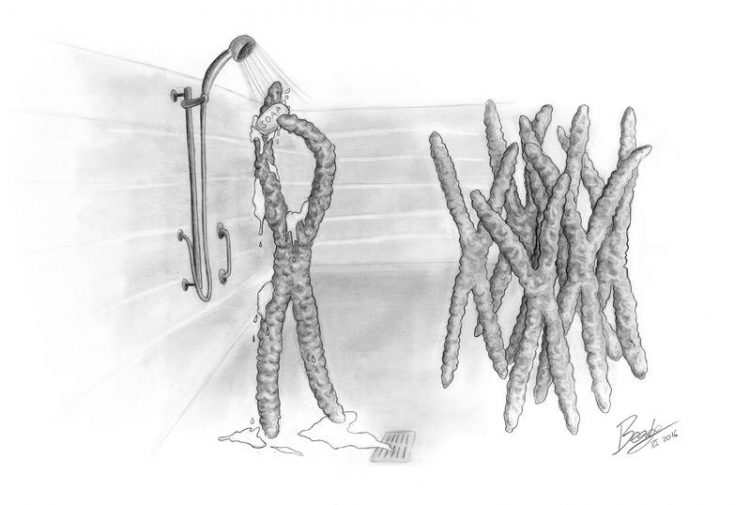A protein coat helps chromosomes keep their distance

The surface of chromosomes is covered with surfactant-like proteins during cell division. These proteins act similar to soap to disperse chromosomes and prevent them from clustering together. IMBA/Mierzwa
Billions of your cells divide every day. Cell division fuels growth and also replaces short-lived cells in some organs, like your skin, blood, and gut.
Dividing cells cycle through different stages. During most of this cycle, cells are at work expressing genes. At this stage chromosomes are spread out as a network of long threads that fill the entire volume of the cell nucleus.
As the cell prepares to divide, the chromosomes replicate and undergo a dramatic metamorphosis. They compact into iconic X-shaped bodies which can move around independently to transport one copy of the genome to each of the daughter cells. But what enables this “individualization” of chromosomes in dividing cells has been a mystery.
A team led by Daniel Gerlich at IMBA discovered that the protein Ki-67 prevents
chromosomes from sticking together in dividing cells. Ki-67 is a well-known marker of proliferating cells and is used in cancer diagnostics to measure erratic cell division. But the function of Ki-67 in the cell was unclear. Their findings, published in the current issue of Nature, show that the chromosomes can still compact without Ki-67, but they merge into a single mass and are essentially immobile. As a consequence, cells lacking Ki-67 divide more slowly.
The team set out to determine how Ki-67 disperses chromosomes in dividing cells. Sara Cuylen, first author of the study, explains: “one end of the Ki-67 protein is attracted to chromosomes, whereas the other end extends away from them.
As a result, Ki-67 forms elongated brush-like structures at the chromosome surface – essentially a barrier that keeps them apart.” These properties of Ki-67 are reminiscent of surface-active agents (surfactants) like soap – which we use daily to break up dirt and grease. That proteins can function as surfactants inside the cell was completely unexpected.
Daniel Gerlich points out that a surfactant mechanism might also control the spatial arrangement of other cell organelles: “The cell contains many other compartments that are not confined by membranes and it was previously unknown how these compartments maintain spatial separation. It will be exciting to search for other proteins with surfactant-like properties, and to study their potential role in cellular organization”.
Original publication: Cuylen, S., Blaukopf, C., Politi, A.Z., Müller-Reichert, T., Neumann, B., Poser, I., Ellenberg, J., Hyman, A.A., Gerlich, D.W. (2016), Ki-67 acts as a biological surfactant to disperse mitotic chromosomes. Nature DOI: 10.1038/nature18610
Press contact:
Ines Méhu-Blantar
IMBA Communications
Dr. Bohr Gasse 3, 1030 Vienna, Austria
Tel.: +43 664 80847 – 3628
Ines.mehu-blantar@imba.oeaw.ac.at
Weitere Informationen:
http://www.imba.oeaw.ac.at/
http://de.imba.oeaw.ac.at/index.php?id=516 (Press pictures)
Media Contact
All latest news from the category: Life Sciences and Chemistry
Articles and reports from the Life Sciences and chemistry area deal with applied and basic research into modern biology, chemistry and human medicine.
Valuable information can be found on a range of life sciences fields including bacteriology, biochemistry, bionics, bioinformatics, biophysics, biotechnology, genetics, geobotany, human biology, marine biology, microbiology, molecular biology, cellular biology, zoology, bioinorganic chemistry, microchemistry and environmental chemistry.
Newest articles

Trotting robots reveal emergence of animal gait transitions
A four-legged robot trained with machine learning by EPFL researchers has learned to avoid falls by spontaneously switching between walking, trotting, and pronking – a milestone for roboticists as well…

Innovation promises to prevent power pole-top fires
Engineers in Australia have found a new way to make power-pole insulators resistant to fire and electrical sparking, promising to prevent dangerous pole-top fires and reduce blackouts. Pole-top fires pose…

Possible alternative to antibiotics produced by bacteria
Antibacterial substance from staphylococci discovered with new mechanism of action against natural competitors. Many bacteria produce substances to gain an advantage over competitors in their highly competitive natural environment. Researchers…





















